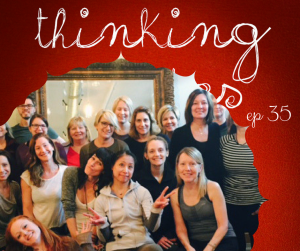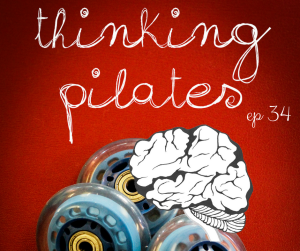Ep 35: Circle of Trust – LIVE Round Table @ Village Pilates, Chicago
Podcast: Play in new window | Download
Subscribe: Apple Podcasts | RSS
What is a circle of trust? It’s a gathering of people who honor the process, not the outcome. It’s a coming together of diverse histories, experiences, strengths, skills, motivations, and talents in order to discover…something or maybe nothing.
The first and only place I’ve ever heard of a circle of trust is from author Parker J. Palmer in his book “A Hidden Wholeness: The Journey to an Undivided Life.” He also talks about the COT in one of my all time favorite books, “The Courage to Teach.” Palmer talks about the essence of a COT this way: “Honest, open questions are countercultural…”
Honest and open questioning is what you are about to listen to.
This episode is a very special moment in time with teachers who are exceptional, not for their technical skill, although that is in no short supply, but for their willingness to be vulnerable, to discover, and to be neither right nor wrong but instead aware and awake.
It might sound like I’m over-reaching or over-congratulating them, but if you were there you’d undoubtedly agree that there is something in the community at Village Pilates Studio that far surpasses most of the studio environments that you’ve experienced.
A heartfelt THANK YOU for all of the kindness and generosity extended to me by Regan Zubak and the teachers of Village Pilates, including Len Palomi, Kay Harmon, Julia Haptonstahl, Andy Cox, Cathy Ditto, Krystal Lee, Misti Fredstrom and those who came from afar: Sarah de Guia, Stephanie Constadine, Becky Vento, Becky Lenski, Naydia Miller Kull and so many others.
What an honor.
Heroes
Our “hero” for this episode is the aforementioned Parker J. Palmer and his book “A Hidden Wholeness: The Journey to an Undivided Life.” I’ve “read” (listened to) this book several times now and it never disappoints. Along with his other book “The Courage to Teach” have helped me make some of the greatest shifts in my life and in my teaching and in bringing the two into balance, aligning them along the mobius strip.
A Hidden Wholeness is a relatively short read and is likely to nudge you in a direction that brings you a little closer to cultivating not only a fulfilling and successful teaching career, but a joyful and fulfilling life.
Here are a couple of quotes from A Hidden Wholeness that have been top of mind for me lately:
“Afraid that our inner light will be extinguished or our inner darkness exposed, we hide our true identities from each other. In the process, we become separated from our own souls. We end up living divided lives, so far removed from the truth we hold within that we cannot know the “integrity that comes from being what you are.”
“Solitude does not necessarily mean living apart from others; rather, it means never living apart from one’s self.”
“First, we all have an inner teacher whose guidance is more reliable than anything we can get from a doctrine, ideology, collective belief system, institution, or leader. Second, we all need other people to invite, amplify, and help us discern the inner teacher’s voice”
I hope you’ll investigate this resource and that it might take you to new and unknown, or rarely frequented, places.
Pro Tip
The Pro Tip for this episode is super simple: Allow your students to LEAD you.
This is different than teaching to the person/body in front of you. It is allowing the student and the body to make decisions independent of you and your feedback, cueing, opinions.
I worked with a wonderful and incredibly talented teacher at VPS who allowed me to help LEAD her out of herself and her present moment stories into a reclaimed sense of joy in movement. You’ll just have to listen to the podcast to get the juicy stuff, but the bottom line is this:
After you’ve cued, aligned, taught, touched, and demonstrated, it’s TIME TO SHUT UP AND BACK UP! Get out of the way. Students can’t find their own path, honor their own journey unless you get out of the way.
Consider the difference between guiding a student toward understanding and allowing a student to let their body guide them. In my experience this is the difference between “telling” our students what and how to be and giving our them permission (and an opportunity) to trust themselves.
Ultimately this is about letting your work migrate from higher brain function where there’s a steady list of things your student needs to accomplish, to lower brain function, where the list dissolves into knowing, intuitive, and responsive.
All it takes is this:
“Now, just move. Allow yourself to move and find the easiest, most enjoyable path into and out of the exercise/movement. Don’t think about the pieces, FEEL the whole. Move when you’re ready and at the pace and within the rhythm that feels organic.”
What would happen?
We risk very little in this moment. In fact, we take US out of the equation entirely and leave it up to the student to truly DISCOVER what is in them.
How could you do this today? Tomorrow?
(Good luck and we’re all counting on you 😉
Links and Resources
Learn More About Village Pilates Studio
- VPS website: http://www.villagepilatesstudio.com/
Learn More About Parker J. Palmer and the Center for Courage & Renewal
Connect With Us
- Email us at thinkingpilatespodcast@gmail.com or use the form below.
- Find us on Facebook at The Thinking Pilates Podcast
Reach us Individually
- Chantill – chantill@skillfulteaching.com
- Phone – (707) 738-7951
- Debora – dkolwey@gmail.com



 How are you showing up? Why are you showing up? Why do you teach? What IS teaching? Why do you care? This is Skillful Teaching: A Whole-person approach to being an expert teacher, not an expert technician. There's a difference. Want to know what it is?
How are you showing up? Why are you showing up? Why do you teach? What IS teaching? Why do you care? This is Skillful Teaching: A Whole-person approach to being an expert teacher, not an expert technician. There's a difference. Want to know what it is?